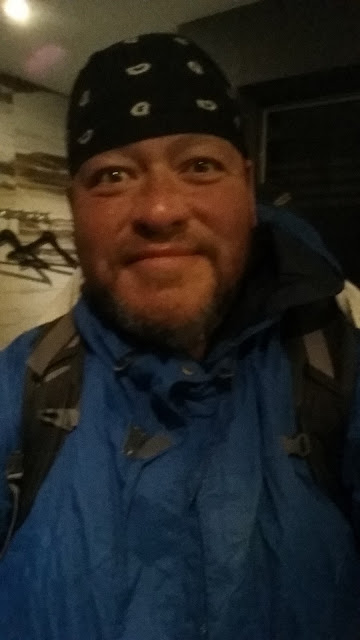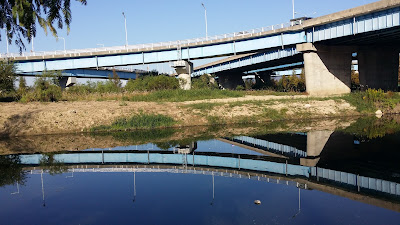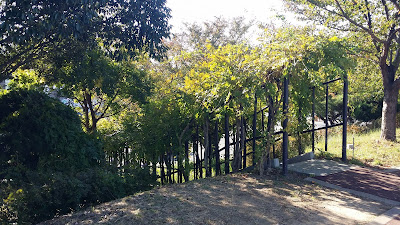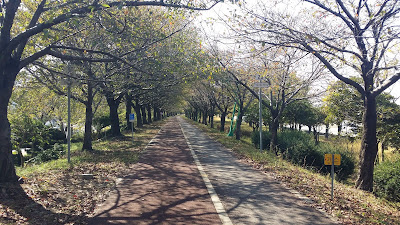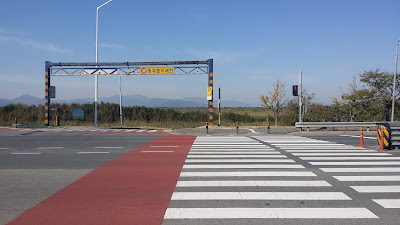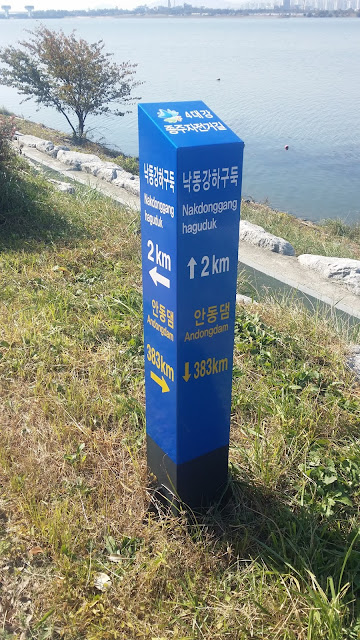What a walk, eh?
Despite the horrible sunburns on my hands and wrists and face, despite the chronic foot pain and the minor inconveniences when dealing with bitchy motel managers, I'd have to say that this third trek along the Four Rivers bike path was the best walk yet. I lost the most weight I've ever lost while on the trail, and I avoided the dishonor of entering a vehicle and being driven any distance. Nothing but walking, baby. My own two feet.
Stats
Differences Between 2020 and 2019/2017
This was my third time along the Four Rivers trail. Above, I described this experience as "the best walk yet." Let's unpack what "best" means. First, this walk didn't see me get into a motor vehicle of any kind. In 2017, I had no choice but to be SUV'ed from one guest house to another, and this caused problems because I had to perform make-up walks. Last year, I stopped at a dam and got a ride to the Jeok Gyo Jang Motel, ten kilometers down the road, because I didn't think I'd have it in me to do those final kilometers after having already walked 32K. This year, I bit the bullet and walked the full 42K instead of accepting a ride.
Second, I didn't camp at all this year, which did make me feel silly for wearing a backpack that proved unnecessary. If I ever do this walk again, I'm going to figure out a way to avoid camping and wearing a backpack. The resulting lack of encumbrance will mean a reduced number of calories burned, but the improved level of comfort will be worth it.
Third: I had ordered Survival Tabs, thinking I'd need to eat them the day before a camping day (as a way to avoid having to take a squat), but (1) the Survival Tabs never arrived because of a Korean Customs snafu, and (2) it turned out I didn't camp, so I didn't need them. Meanwhile, I tried and tried to contact Hanjin Shipping about the Customs issue, but I got no response. The Survival Tabs are gone, as far as I'm concerned. Money wasted.
Fourth: I'll talk about this a bit more in the following section, but I experienced a lot less pain this time around. This was surprising, given how little pre-walk conditioning I'd done. In 2017, I took my conditioning pretty seriously, walking encumbered along the local Yangjae Creek, going up and down staircases and getting myself ready for what I believed to be a massive endeavor. Last year, I conditioned myself even less, and this year, I was even lazier about prepping my body for the rigors ahead. I think I was betting that the conditioning I had done over the years would have sunk deeply into my bones and could be brought back to the surface after just a few days on the trail. And I think I was right: the body does indeed remember and adjust itself to the effort of distance walking.
Fifth, the actual route I took did vary at certain points this time around, as you will have read if you followed my journey from the beginning. I found a couple shortcuts, and I stitched together certain segments to avoid camping, and the result was, on occasion, different terrain and scenery. Every single walk has been unique in that regard, and this is partly due to the fact that the Four Rivers path is itself not a single path so much as a network-like set of paths that all generally lead you down from Incheon to Busan. There were choices and options, some of which took me along detours or alternate routes. Except for my beast of a 44K day, I enjoyed every diversion.
Footwear, Damage to Feet, and Foot Pain in General
The new, foot-hugging hiking socks I wore proved to be pretty good—almost as good as my old, reliable REI socks that date back to 2008. I think they may have contributed to the bruising under some of my toenails (bruising that always eventually ends up with me losing toenails), but there was little to no sock-related pain. And my New Balance walking shoes, which I had thought might be a problem, proved to work better than anticipated. I had thought the shoes' tongues would bunch up and abrade the tops of my feet, but that never happened. I had also worried that the sides of the shoes would pinch my pinky toes, and while that did happen (my right pinky toe is only now shedding the thick, dead skin of a blood blister that had formed early in the walk), the problem wasn't as pronounced as on previous walks. I suffered very little toe-pinching pain. My third worry had to do with the "pre-wear" of this pair of shoes: I had bought the New Balances sometime last year, I think, and they had already been through a lot of local distance walking, so I wondered whether the soles' treads might have been wearing down. They were, in truth, a bit worn at the start of this walk, but I took a gamble and didn't buy a new pair of shoes. Result: the soles did wear through one layer of rubber by the end, but this wasn't enough to cause foot-support problems. As things turned out, I was just fine. And because I didn't wrap my right pinky toe in Leukotape, I didn't experience any of last year's horrific swelling and fungus.
Other Health-related Issues (Colds, Hay Fever, etc.)
I had brought along my pharmacopeia, which included things like painkillers and cold medicine, but the pills I ended up using the most, aside from my ibuprofen, were my Claritin allergy pills. For the first half of the walk, I felt as if I were either suffering from hay fever or reacting badly to dust or microorganisms in the motels where I stayed. The problem was annoying, but not debilitating. There were a few days where I thought I might be catching a cold; aspirin and sore-throat meds took care of that feeling. The latter half of the walk was largely free of all these problems, luckily.
Relative Friendliness of Bikers
The bikers I encountered along the way followed the general rule that, the closer you are to big cities, the more standoffish they become. Being out in the middle of nowhere somehow correlated to more overt friendliness; I jokingly thought of the boonies as "the Greeting Zone" as a result: I could nod in greeting to a passing biker, and he'd nod back or even utter a greeting. But near cities like Daegu and Busan? Forget about it. The final day's hike to the estuary was one of the most unfriendly, standoffish hikes of the whole trip, and I finally gave up on greeting any passersby.
The Rattlesnake Issue
You'll recall I saw a tail-twitching snake on my way downhill from the Ihwaryeong gate on Day 13. So I Googled "snakes that twitch their tails when threatened" because I was curious as to whether I had seen an honest-to-God rattlesnake, despite my buddy Charles's statement that rattlers are found only in the Americas. Were there other snakes that twitched their tails? I wondered.
Here's what Animals.Mom.com says:
Most rat snakes, kingsnakes, gopher snakes, pine snakes, bullsnakes, milk snakes and kingsnakes [sic] vibrate their tails when frightened. While they're not as loud as the sounds produced by rattlesnake tails, they do often create an audible buzz as their tails contact substrate or cage fixtures.
That's enough to convince me that the snake I'd encountered was no rattler. I'm still not sure what kind of snake it was, but I might follow Charles's advice and slap my images up at some site devoted to talking about snakes. So: mystery solved. Sort of. That was definitely not a rattler.
The Equipment Review
I ended up hiking with a lot of equipment that I ultimately didn't need. This was because I had initially thought I would be camping at least one day on the trail. Thanks to some rerouting via Naver Map that I did while en chemin, I managed to eliminate all camping days. This proved to be a mixed blessing: the 44K segment took me along local highways, forcing me to play in traffic. That segment was also a slog: it's one thing to walk 60K from Seoul to Yangpyeong with no encumbrance, but quite another to walk 44K with an 11-kilo pack on my back. My feet had been relatively undamaged up until that day, but after doing the segment from hell, the blisters started appearing. I am, however, now convinced that a person can hike across South Korea without a backpack if the route is carefully plotted out. Upshot: I'm going to talk about the performance of my equipment now, but keep in mind that, in reality, most of it proved to be superfluous.
We'll begin with my beloved backpack, the Gregory Baltoro 85, which I purchased in 2018 and used during last year's trek along the Four Rivers path. The pack performed admirably; the chest strap remained where it was and didn't pop off. While it's too soon to say, it could be that Gregory did, in fact, improve its chest-strap design. We'll revisit this issue in a few years; my old Gregory Whitney 95 didn't develop a chest-strap problem until it was fairly old and worn. My current Baltoro has great storage capacity, and its array of pockets makes it convenient to use: everything is easily accessible, such that unpacking and repacking are both a cinch to do in a short amount of time. The pack's hip-belt assembly remains problematic: it's still not designed with us fatties in mind, so as you know from previous blogs, I've jury-rigged the thing by slipping in my own leather belt, with its old-school prong-and-hole setup. The Baltoro also sits more evenly on my back than the Whitney ever did; the Whitney used to lean annoyingly in one direction or another. On the rare occasions when the Baltoro wasn't properly settled on my shoulders, it was easy enough to tug on some straps to readjust the pack's position. All in all, I'd say that, if you're going to go backpacking, you really ought to go Gregory. (I wouldn't mind becoming a shill for the company, to be honest. Gregory would be an awesome sponsor.)
My New Balance walking shoes are worth a few column-inches. I got these shoes via Amazon; they're size 13s, and they're the widest shoes that Amazon sells. As I mentioned earlier, I had purchased these shoes long before this walk, so they were already a bit worn in the soles when I started the trek this past September 28. Luckily, the shoes performed well, reducing my overall foot pain and not developing any sole holes. The PowerStep orthotics inside my shoes proved to be just what the doctor ordered, far outperforming the painful Costco orthotics that my boss had given me.
My Cascade trekking pole, purchased at Yangjae Costco back in 2017, somehow lasted the entire hike despite there being a very well-worn goat's foot at the pole's tip. I was, in the end, too lazy to hunt down a proper replacement tip for the pole before the walk began, so my laziness led me to gamble that I could make the 600-plus-kilometer journey with what I had. The gamble paid off, but the tip is now so worn that, if I use the pole for a subsequent long walk, I'll have no choice but to either replace the tip or buy a new pole for next time.
My hat and my toshi (sleevelets) both worked out fine. As the photos at the beginning of this epilogue will attest, the toshi, despite being rather timeworn after years of use, were particularly effective at screening out the sun, leaving my hands to bear the brunt of Sol's unrelenting wrath. My hat didn't entirely protect my face, but once the initial sunburn appeared on my nose, and once the initial peeling had occurred, my face was fine after that.
The Chinese-language Question
When I was by the Chilgok Dam on Days 17 and 18 (October 14 and 15), I took a walk up a local hill to a structure that seemed temple-like at first glance, but which proved to be little more than an observation tower. There was a Chinese inscription at the tower's entrance that looked like this:
Kevin, the Chinese writing on the pagoda structure you came across translates as “Guanyin’s Hands Temple.” Guanyin is a famous goddess in the Chinese sphere, especially in Taiwan.
Walking Without Actually Needing a Backpack
Once I discovered how to avoid camping by stitching certain segments together and/or using shortcuts, it felt silly to walk with a backpack. I credit the backpack with aiding my weight loss, but aside from that (and as much as I love my Gregory), the pack felt superfluous. I haven't solved the question of which specific gear items I'd drop, nor have I thought through the question of what I'd use in place of the Gregory, but I have about a year to ponder these problems.
That said, I can engage in some tentative speculation. John McCrarey had asked me, early on, what sort of alternative pack I'd use, and the design that keeps floating into my head is something custom-made and based roughly on a Scottish kilt: my scaled-down pack wouldn't be a backpack so much as a hippack (if that spelling isn't too awkward). The idea is to keep the weight of my gear off my spine and shoulders. In my hypothetical hip-pack (yes: let's insert a hyphen to make things less awkward), there'd be a system of large pockets and straps that would dangle from my waist like an exaggerated, saddlebaggy version of Batman's utility belt. The hip-pack would be able to hold a foam roll (via straps), if necessary, but it wouldn't be built to hold other camping gear. The pack would be secured by belting it around the waist, so maybe it should be called a waistpack instead. The idea riffs off the hip-belt assembly of a standard hiker's backpack: the idea is to keep the weight of one's gear firmly on one's hips, and never on the back and shoulders. I imagine the various pockets dangling down to about knee level, but unlike a kilt, which is a unified skirt, each vertical "column" of pockets would be mounted on its own separate, independently swinging rectangle of tough fabric—maybe five such rectangles in total. The pockets would be capacious, but they'd hang below waist level so as not to impede arm swing. The end result might actually be pleasing to other hikers, too: you'd have a much lower center of gravity once you loaded all your gear into the waistpack (or whatever we end up calling it), and no back or shoulder strain at all. This is a pack, of course, not a clothing item: you'd still be wearing your hiking pants, so you wouldn't have to worry about showing off your manly bits as you walked while wearing this thing. What I haven't figured out is how the waistpack will behave once your legs achieve a steady hiker's rhythm. Will the rectangular flaps rub annoyingly against your legs, possibly abrading your skin and/or the fabric of your hiking pants, or will they swing in a comfortable way that goes along with your stride? Anyway, I have only the vaguest of ideas of how this sort of pack might work, and I haven't found anything like what I'm describing online anywhere, although that doesn't mean much: I haven't done an exhaustive search yet. The upshot is that I'd like to have a plausible design ready for my big walk next year. Maybe I'll get it patented. Stay tuned. Whenever I create my Kevin's Walk 5 blog, I'll probably be talking more about this waistpack, or hiker's kilt, or whatever I end up calling it.
Fitness, Conditioning, and Weight Loss
If distance walking is when I'm manifesting my best self, then a life of distance walking would be ideal for me: I'd be up before sunrise, walking all day at a slow-and-steady pace for nine or ten hours, and burning so many calories that I could afford not to cut back too much on what I eat. Hill walking has proved great for cardio, although I have to admit that the Four Rivers path, which is over 90% flat, isn't the hilliest terrain by any means. But walking, as a habit and a practice, can be done even when I'm not engaged in an ambitious trans-Korea project. There are several local paths that I can access right from my apartment, so there's no shortage of places to walk to, and no excuse not to be out walking (except when it's snowy or icy—safety first!). I've been back home for three weeks now, as I write these words, and I haven't done any ambitious walking since coming back, but I do plan to start up a walking regimen soon—perhaps one that involves using my backpack again, given how that increases my calorie-burn rate. While home, I can never recapture the ambitious scale of a trans-Korea walk: I have a job, so I can't walk 9-10 hours per day; I have to settle for much shorter walks of 3-4 hours.
That brings up the issue of conditioning, especially for my feet. Early in 2020, on February 13, I suffered a stress fracture in my right foot. After the foot healed, it remained achy and somewhat swollen, but even though I never went back to the orthopedic clinic for a second X-ray of my foot, I'm convinced the foot became even stronger than than it had been before the fracture. The proof is that I walked for a month on a far more brutal schedule than anything I'd been doing in February. As I mentioned before, I also didn't bother too much with training for the walk this time around, and that's partly because I trusted my feet to be, at this point, thoroughly conditioned to distance walking. Even after a hiatus of several months, my feet would remember their conditioning and quickly adapt to demanding distance-walking conditions. Although my right foot remains slightly swollen for some mysterious reason, the swelling was not at all an impediment during this latest walk. So once I begin the above-mentioned truncated walking regimen, I trust that my feet will be fine. They're always achy; I've been in constant low-level pain since I became a committed distance walker, and I don't expect the pain to go away unless I lose a ton of weight. Will that happen anytime soon? We'll see. We'll see.
What I'll Miss About This Trail
It saddens me that I won't be back this way again for a long time, but there are other paths to explore. This particular gukto-jongju has become a trusted companion. While it's been somewhat different every time I've walked it, it's also become familiar to me, and I'll miss that familiarity. Given how carefully I plotted out my walk in 2017, and how faithfully I followed that original plot both last year and this year, I can also say that I've come to appreciate this path's "rhythm." As a walker, you're being proactive and pushing yourself along a given path, but at the same time, the path is "happening" to you as well, and the Four Rivers trail has its own special way of unfolding before you, changing mood and character with every kilometer, but also changing in major phases as you move from one distinct segment to the next—from the Ara Canal to the Han, from the Han to the Saejae path, and from the Saejae to the quietly dignified Nakdong River section that dominates the final half of the journey. I'll miss the trees, the rice fields, the occasional hills, the wildlife, the sun, the wind, the curves, the straightaways, the mountains, and the big sky. Even though it was sometimes a chore to be a shutterbug, photographing every little thing, I'm glad I have three blogs' worth of memories that I can keep coming back to as the years roll on.
What the Future Holds
The east-coast gukto-jongju beckons, and I have a lot to plan. But beyond that path, there are so many others. I must once again thank reader Daeguowl, a.k.a. Paul Carver, for having provided me with PDFs of comprehensive trail maps for just about every biking (and hiking?) trail across the country. For my own convenience, I plan to compile those PDFs into a huge document and have them printed out in book form so that I can flip through the maps physically and see more closely what paths are available to me. That ought to make for an impressive tome. I do know, from a cursory reading of those PDFs, that it's possible to walk a path similar in shape to Abe Lincoln's beard (roughly, a "U" shape) that follows the peninsular coast from Incheon down to Gwangju, across to Busan, and up to Gangneung. I'd like to do that trail someday. At a guess, it's at least 1700 kilometers long. That might take me more than a few days to do.
As for the future-future... I don't know. I'm now 51, and as I'm sure I've written before, I don't know how many more of these walks I have left in me. My buddy Mike has invited me to join him on a walk along the Camino de Santiago (The Way of Saint James), which is, in reality, not one single camino but nine different paths that vary wildly in length and difficulty. Mike wants to do this walk when we turn 60, so he's got several years to get his own body in proper condition for such an undertaking, and I, meanwhile, have to make sure I don't get lazy and allow myself to de-condition. If, at some point, I change jobs and go back to university teaching, I'll consider hiking during the summer months, but only in cooler northern latitudes (oh, Canada?). There's plenty of hiking and distance walking to be done all over the world, so the sky's the limit in terms of where I might go. Then again, I'm also perfectly happy just to keep exploring South Korea: there are enough paths in those PDFs to keep me occupied until I'm a senile old cripple.
And that, Dear Reader, is all I have to say about this latest walk of mine—the third and the best of my Four Rivers walks. It was fun; it was bittersweet; it was educational; it was humbling; it was inspiring; it was memorable, exactly like the walks before it. I'll be back this way again someday... just not yet.
my friends, my friends, the stick and pack!now in my hand and on my back
we step into the morning dark
and on a journey we embark
the path ahead is long and rough
but morning sun will be enough
our pace, so eager, knows no slack
we walk across the dragon's back!
we focus on the road ahead
we go where others may have led
their bravery a guiding star
their deeds defy us to walk far
and so I walk, but ne'er alone
my friends, who hear my ev'ry groan
in balmy sun or rainy wrath
with stick and pack, I find my path
for what is life if not a walk?
a chance to hear the cosmos talk?
we set ourselves a goal each day
but more than goals, we prize the way!
a million steps through time and space
the flowers shine and waters race
but when we reach the journey's end
the path is now another friend
we step into the breaking dawn
the path is here but leads us on
so forth we go, friends: stick and pack!
we walk across the dragon's back!










